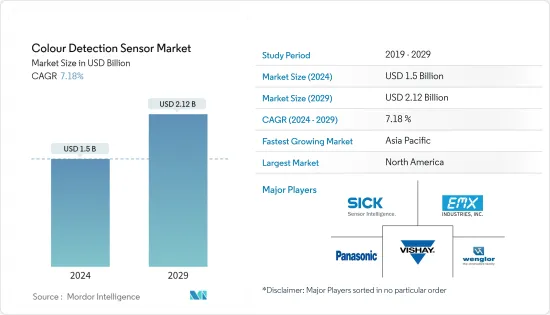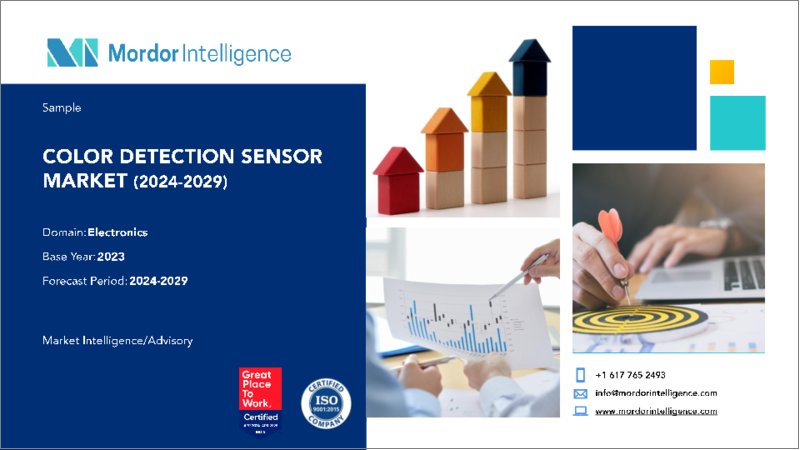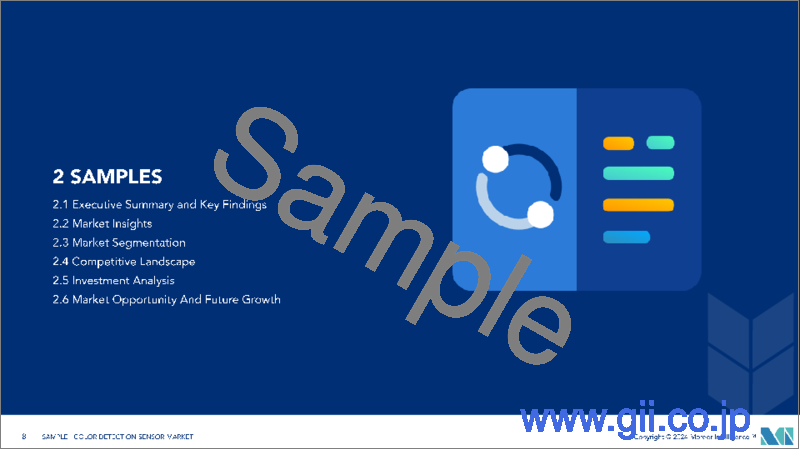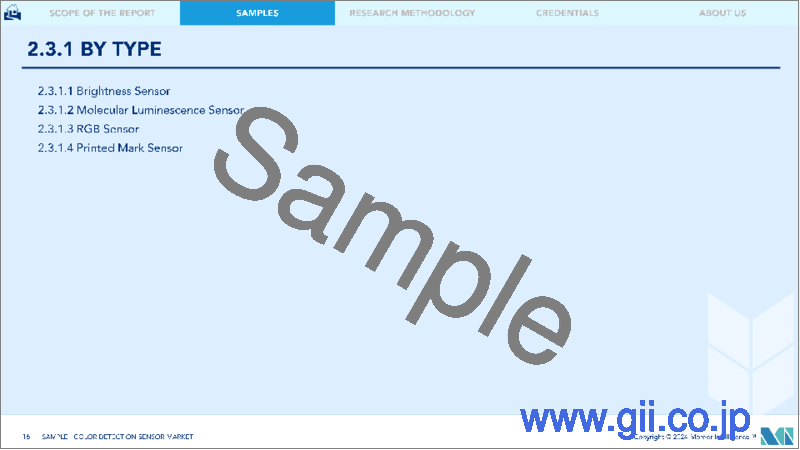|
|
市場調査レポート
商品コード
1548614
色検出センサー:市場シェア分析、産業動向、成長予測(2024~2029年)Colour Detection Sensor - Market Share Analysis, Industry Trends & Statistics, Growth Forecasts (2024 - 2029) |
||||||
カスタマイズ可能
適宜更新あり
|
|||||||
| 色検出センサー:市場シェア分析、産業動向、成長予測(2024~2029年) |
|
出版日: 2024年09月02日
発行: Mordor Intelligence
ページ情報: 英文 152 Pages
納期: 2~3営業日
|
全表示
- 概要
- 目次
色検出センサー市場規模は2024年に15億米ドルと推定され、2029年には21億2,000万米ドルに達すると予測され、予測期間(2024-2029年)のCAGRは7.18%で成長します。

色検出センサーは対象物に光を照射し、直接反射または出力を測定します。これらのセンサーの多くは一体型光源を備えており、所望の効果を確実に達成します。これらのセンサーは、着色された製品の等級付け、コード化されたマーキングの識別、パッケージ上の粘着剤やデータコードの存在の確認において極めて重要です。主な用途は、真の色認識とカラーマーク検出です。真の色認識用に設計されたセンサーは、色または色合いを区別する必要があり、多くの場合、選別または照合モードで動作します。
主なハイライト
- 拡散技術を利用したカラーセンサーは、広範な色を検出するために開発されました。これらのセンサーは、カラーセンシングを行うために、カラーセンシティブフィルターとセンサーアレイの組み合わせを採用しています。このデータにより、画像や指定した対象物の色を分析します。カラー測定プロセスには通常、ターゲット表面を照らす光源と、反射された波長を捕捉して測定するレシーバーが含まれます。
- スマートフォンへのカラーセンサーの統合は、色検出センサーの成長に大きく影響します。スマートフォンのカラーセンサーは自然光と人工光を区別し、これらのデバイスの光学レンズの機能を強化します。カラーセンサーをIoTやAI技術と統合することで、リアルタイムのデータ分析や意思決定が可能になり、用途がさらに向上します。
- 色検出センサーは、繊維製品のような産業で重要な役割を果たし、生産における色の一貫性を確保し、産業オートメーション・セットアップの定番となっています。飲食品、商業印刷、消費者印刷、家電、自動車、医薬品、ヘルスケア、化学などの業界では、微妙な色の違いも識別するために、これらのセンサーの使用が増加しています。
- 初期コストの高さは、色検出市場の成長を制限する一因となっています。色検出センサーは、製造工程における品質管理と一貫性の確保、色検出の精度と信頼性の向上など、数多くの利点を提供する一方で、そのコストが採用の障壁となる可能性があります。
- パンデミックの影響は弱まったもの、自動化とロボット工学の魅力は依然として強く、さまざまな業界がこれらの技術への投資を活発化させています。IFRによると、産業用ロボットの世界導入台数は今後数年で急増します。2026年の設置台数は71万8,000台に達し、2022年の55万3,000台から増加します。このような成長軌道は、特に包装、自動車、繊維、ヘルスケアなどの分野で、カラーセンサーがオートメーション・セットアップの重要な要素として脚光を浴びるにつれて、調査した市場にとって有望なイメージを描いています。
カラー検出センサーの市場動向
飲食品産業がエンドユーザーとして急成長
- 飲食品業界では、色と外観は製品の成功にとって極めて重要です。そのため、原材料から最終製品に至るまで、色検出センサーの需要が急増しています。高精度で知られるこの技術は、固形物や液体から粉末や顆粒に至るまで、様々なサンプルの色属性を評価することを可能にします。
- あらゆる不一致を迅速に突き止めることで、企業は色の品質基準を満たし、プロセスを合理化し、無駄を減らして利益を高めることができます。これらのセンサーを導入することで、最終製品が一貫して望ましい視覚的基準を満たすことが保証され、ブランドの評判と顧客満足を維持するために極めて重要です。
- 原材料は、味や食感だけでなく、食品に視覚に訴える色を加えるためにも重要です。穀物、粉末、砂糖、ココアなど、原料の化学的性質は多様であるため、それぞれに合わせた試験アプローチが必要となります。食品加工部門は、原材料の色の重要性を認識し、最終製品の色の品質を保証するために、高度に標準化された方法を選択します。これらの方法では、色のわずかな変化も正確に検出できる高度な色測定装置を使用し、最終製品の視覚的な一貫性と消費者への訴求力を確保します。このように色の品質に細心の注意を払うことは、規制基準や消費者の期待に応えるために不可欠です。
- 飲食品業界では、これらのセンサーは食肉生産の安全性と品質管理の監視に役立っています。厳しい規制と飲食品包装に対する要求の高まりにより、色検出センサー、特にカラーマークと登録アプリケーションは不可欠なものとなっています。
- さまざまな国での包装食品の消費も、市場の成長を支える主な要因です。例えば、オーガニック・トレード・アソシエーション(Organic Trade Association)によると、包装されたオーガニック食品の消費は世界的に伸びています。米国では、年間消費額は2018年の174億6,000万米ドルから2025年には250億6,000万米ドルに達すると予測されています。
アジア太平洋が大きな成長を遂げる見込み
- テクノロジー主導の分野で専門知識を持つ米国が市場を独占しています。国際貿易局によると、米国は産業オートメーション用機器の世界の主要生産国であり、これにはハードウェアや、産業・製造現場でシステムの自動化に使用されるコンポーネントが含まれます。
- 自動車、石油・ガス、電力などの産業への継続的な支出は、産業オートメーションへの需要を増加させ、色検出センサーの市場を含むオートメーションに関連する市場を後押ししています。
- 米国ではここ数年、スマート・カラー・カメラとスマート・カラー・センサーの売上が大きく伸びています。スマートカラーセンサーによって、この技術は大きな進歩を遂げました。より優れた色解像度を提供します。また、多くのメーカーがこれらのセンサーのバージョンを提供しており、キャリブレーションされたRGBカラー結果を得ることができます。
- 米国における市場の主要企業の確固たる存在感と、これらの主要企業によるカラーセンサーの継続的な開拓は、市場で重要な役割を果たしています。例えば、ロックウェルは、同社が提供するスマートセンサを革新することにより、センサポートフォリオを継続的に改善しています。同社の光電センサは、産業オートメーションにおいて最も堅牢であると認識されています。
色検出センサー産業概要
色検出センサー市場は、参入障壁が低いため断片化されています。同市場の主要企業には、SICK AG、EMX Industries Inc.、Wenglor Sensoric GmbH、Vishay Intertechnology Inc.and Panasonic Corporationがあります。
- 2023年11月、SICK Agはカラーセンサーのラインアップを大幅に強化し、高解像度と高速で知られるCSSとCSXモデルを発表しました。SICKの最新フラッグシップモデルであるCSSは、微妙な色合いの違いも識別できる圧倒的な色分解能が特長。微妙な表面の質感を認識する能力に長けているため、用途の可能性が広がります。
- 2023年10月、Balluff GmbHはメキシコのアグアスカリエンテスに新たな生産施設を開設し、センサーとオートメーションのスペシャリストとして、弾力的なサプライチェーンを構築しながら、計画的な成長を実現します。この新拠点は、南北アメリカ地域の顧客に対し、高い可用性と短納期で現地生産された製品を供給するのに役立ちます。
その他の特典
- エクセル形式の市場予測(ME)シート
- 3ヶ月間のアナリスト・サポート
目次
第1章 イントロダクション
- 調査の前提条件と市場定義
- 調査範囲
第2章 調査手法
第3章 エグゼクティブサマリー
第4章 市場洞察
- 市場概要
- 業界の魅力度-ポーターのファイブフォース分析
- 供給企業の交渉力
- 買い手の交渉力
- 新規参入業者の脅威
- 代替品の脅威
- 競争企業間の敵対関係の強さ
- 産業バリューチェーン分析
- 技術スナップショット
- 産業オートメーション
- 家庭用電子機器
- 流体・ガス分析
- 照明とデジタルサイネージ
第5章 市場力学
- 市場促進要因
- 様々な産業におけるプロセスの自動化
- スマートフォンにおけるカラーセンサー使用の増加
- 市場抑制要因
- 初期コストの上昇
第6章 市場セグメンテーション
- タイプ別
- 輝度センサー
- 分子発光センサー
- RGBセンサー
- 印刷マークセンサー
- エンドユーザー産業別
- 飲食品
- ヘルスケア
- 化学
- 繊維
- 自動車
- 家電
- その他エンドユーザー産業
- 地域別
- 北米
- 欧州
- アジア
- オーストラリア・ニュージーランド
- ラテンアメリカ
- 中東・アフリカ
第7章 競合情勢
- 企業プロファイル
- SICK AG
- EMX Industries Inc.
- Wenglor Sensoric GmbH
- Vishay Intertechnology, Inc.
- Panasonic Corporation
- Astech Applied Sensor Technology Gmbh
- Banner Engineering Corp.
- Keyence Corporation
- Baumer NV
- Rockwell Automation Inc.
- Ams-Osram AG
- Datalogic SpA
- Omron Corporation
- SensoPart Industriesensorik GmbH
- Jenoptik AG
- Hamamatsu Photonics KK
- Balluff GmbH
- Pepperl+Fuchs
第8章 投資分析
第9章 市場機会と今後の動向
The Colour Detection Sensor Market size is estimated at USD 1.5 billion in 2024, and is expected to reach USD 2.12 billion by 2029, growing at a CAGR of 7.18% during the forecast period (2024-2029).

Color detection sensors emit light onto objects and measure the direct reflection or the output. Many of these sensors come equipped with integral light sources, ensuring they achieve the desired effect. These sensors are pivotal in grading-colored products, distinguishing coded markings, and verifying the presence of adhesive or data codes on packages. Their primary applications include true color recognition and color mark detection. Sensors designed for true color recognition must differentiate between colors or shades, often operating in sorting or matching modes.
Key Highlights
- Color sensors, utilizing diffuse technology, have been developed to detect a broad spectrum of colors. These sensors employ a combination of color-sensitive filters and an array of sensors to conduct color sensing. This data then analyzes the colors in an image or a specified object. The color measurement process typically involves a light source that illuminates the target surface and a receiver that captures and measures the reflected wavelengths.
- The integration of color sensors in smartphones significantly influences the growth of color detection sensors. Smartphone color sensors distinguish between natural and artificial light, enhancing the functionality of optical lenses in these devices. Integrating color sensors with IoT and AI technologies allows for real-time data analysis and decision-making, further improving their applications.
- Color detection sensors play a crucial role in industries like textiles, ensuring color consistency in production, and are a staple in industrial automation setups. Industries spanning food and beverages, commercial and consumer printing, consumer electronics, automotive, pharmaceuticals, healthcare, and chemicals use these sensors increasingly to identify even the subtlest color variations.
- The high initial costs are one factor restricting the growth of the color detection market. While color detection sensors offer numerous benefits, including ensuring quality control and consistency during manufacturing processes and enhancing accuracy and reliability in color detection, their cost can be a barrier to adoption.
- While the pandemic's impact has waned, the allure of automation and robotics remains strong, prompting diverse industries to ramp up investments in these technologies. According to IFR, the global installation of industrial robots is set to surge in the coming years. 2026 installations will reach 718 thousand units, up from 553 thousand units in 2022. This growth trajectory paints a promising picture for the market studied, particularly as color sensors gain prominence as vital elements in automation setups, notably in sectors like packaging, automotive, textiles, and healthcare.
Color Detection Sensor Market Trends
Food and Beverage Industry to be the Fastest Growing End User
- In the food and beverage industry, color and appearance are pivotal for a product's success. Consequently, the demand for color detection sensors has surged, from raw materials to the final product. This technology, known for its high precision, enables users to assess color attributes across various samples, from solids and liquids to powders and granules.
- By swiftly pinpointing any inconsistencies, companies meet color quality standards and streamline processes, reducing waste and boosting profits. Implementing these sensors ensures that the final product consistently meets the desired visual standards, crucial for maintaining brand reputation and customer satisfaction.
- Ingredients are crucial, not just for taste and texture, but also for adding visually appealing colors to food products. Given the diverse chemical properties of ingredients like grains, powders, sugar, and cocoa, each necessitates a tailored testing approach. Food processing units, recognizing the significance of ingredient color, opt for highly standardized methods to ensure the final product's color quality. These methods involve using advanced color measurement devices that may accurately detect even the slightest variations in color, ensuring that the end product is visually consistent and appealing to consumers. This meticulous attention to color quality is essential for meeting regulatory standards and consumer expectations.
- In the food and beverage industry, these sensors are instrumental in monitoring safety and quality control in meat production. With stringent regulations and heightened food and beverage packaging demands, color detection sensors, especially in color mark and registration applications, have become indispensable.
- Packaged food consumption across different countries is also a major factor supporting the market's growth. For instance, according to the Organic Trade Association, the consumption of packaged organic foods has been growing globally. In the United States, the annual consumption value is anticipated to reach USD 25.06 billion in 2025 from USD 17.46 billion in 2018.
Asia-Pacific Expected to Witness Major Growth
- Owning its expertise in the technology-driven sectors, the United States dominates the market. According to the International Trade Administration, the United States is the primary producer of equipment for industrial automation globally, including hardware and the components used for the industrial and manufacturing settings to automate systems.
- The ongoing expenditure for industries like automotive, oil and gas, and power is increasing the demand for industrial automation and boosting the market associated with automation, including the market of color detection sensors.
- The significant rise in sales of smart color cameras and smart color sensors has progressed significantly in the United States over the past several years. With the smart color sensor, this technology has made massive gains. It provides a more excellent color resolution. Many manufacturers also offer versions of these sensors that may give calibrated RGB color results.
- The solid presence of the market's leading players in the United States and the continuous development of color sensors by these top players play a significant role in the market. For instance, Rockwell continuously improves its sensors portfolio by innovating smart sensors offered by the company. Its photoelectric sensors are recognized as the most robust in industrial automation.
Color Detection Sensor Industry Overview
The color detection sensor market is fragmented due to low entry barriers. Some key players in the market are SICK AG, EMX Industries Inc., Wenglor Sensoric GmbH, Vishay Intertechnology Inc., and Panasonic Corporation.
- In November 2023, SICK Ag unveiled a significant enhancement to its color sensor lineup, debuting the CSS and CSX models known for their high resolution and speed. The CSS, SICK's latest flagship, stands out for its unparalleled color resolution, excelling in discerning even the most subtle shade variations. Its prowess in recognizing nuanced surface textures broadens its potential applications.
- In October 2023, Balluff GmbH opened its new production facility in Aguascalientes, Mexico, enabling the sensor and automation specialist to achieve its planned growth while creating resilient supply chains. The new site would help the company supply its customers in the Americas region with locally produced products with high availability and short delivery times.
Additional Benefits:
- The market estimate (ME) sheet in Excel format
- 3 months of analyst support
TABLE OF CONTENTS
1 INTRODUCTION
- 1.1 Study Assumptions and Market Definition
- 1.2 Scope of the Study
2 RESEARCH METHODOLOGY
3 EXECUTIVE SUMMARY
4 MARKET INSIGHTS
- 4.1 Market Overview
- 4.2 Industry Attractiveness - Porter's Five Forces Analysis
- 4.2.1 Bargaining Power of Suppliers
- 4.2.2 Bargaining Power of Buyers
- 4.2.3 Threat of New Entrants
- 4.2.4 Threat of Substitute Products and Services
- 4.2.5 Intensity of Competitive Rivalry
- 4.3 Industry Value Chain Analysis
- 4.4 Technology Snapshot
- 4.4.1 Industrial Automation
- 4.4.2 Consumer Electronics
- 4.4.3 Fluid and Gas Analysis
- 4.4.4 Lighting and Digital Signage
5 MARKET DYNAMICS
- 5.1 Market Drivers
- 5.1.1 Process Automation across Various Industries
- 5.1.2 Increased Use of Color Sensors in Smartphones
- 5.2 Market Restraints
- 5.2.1 Higher Initial Costs
6 MARKET SEGMENTATION
- 6.1 By Type
- 6.1.1 Brightness Sensor
- 6.1.2 Molecular Luminescence Sensor
- 6.1.3 RGB Sensor
- 6.1.4 Printed Mark Sensor
- 6.2 By End-user Industry
- 6.2.1 Food and Beverage
- 6.2.2 Healthcare
- 6.2.3 Chemical
- 6.2.4 Textile
- 6.2.5 Automotive
- 6.2.6 Consumer Electronics
- 6.2.7 Other End-user Industries
- 6.3 By Geography
- 6.3.1 North America
- 6.3.2 Europe
- 6.3.3 Asia
- 6.3.4 Australia and New Zealand
- 6.3.5 Latin America
- 6.3.6 Middle East & Africa
7 COMPETITIVE LANDSCAPE
- 7.1 Company Profiles
- 7.1.1 SICK AG
- 7.1.2 EMX Industries Inc.
- 7.1.3 Wenglor Sensoric GmbH
- 7.1.4 Vishay Intertechnology, Inc.
- 7.1.5 Panasonic Corporation
- 7.1.6 Astech Applied Sensor Technology Gmbh
- 7.1.7 Banner Engineering Corp.
- 7.1.8 Keyence Corporation
- 7.1.9 Baumer NV
- 7.1.10 Rockwell Automation Inc.
- 7.1.11 Ams-Osram AG
- 7.1.12 Datalogic SpA
- 7.1.13 Omron Corporation
- 7.1.14 SensoPart Industriesensorik GmbH
- 7.1.15 Jenoptik AG
- 7.1.16 Hamamatsu Photonics KK
- 7.1.17 Balluff GmbH
- 7.1.18 Pepperl+Fuchs





